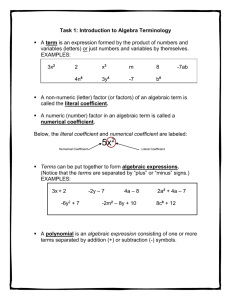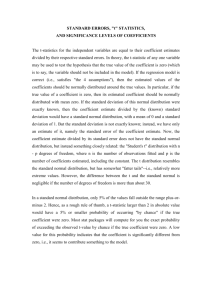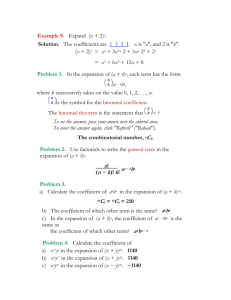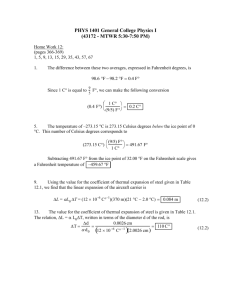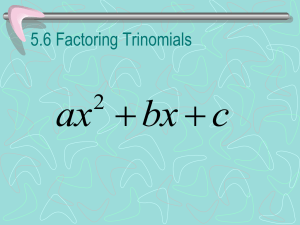Free Sample
advertisement
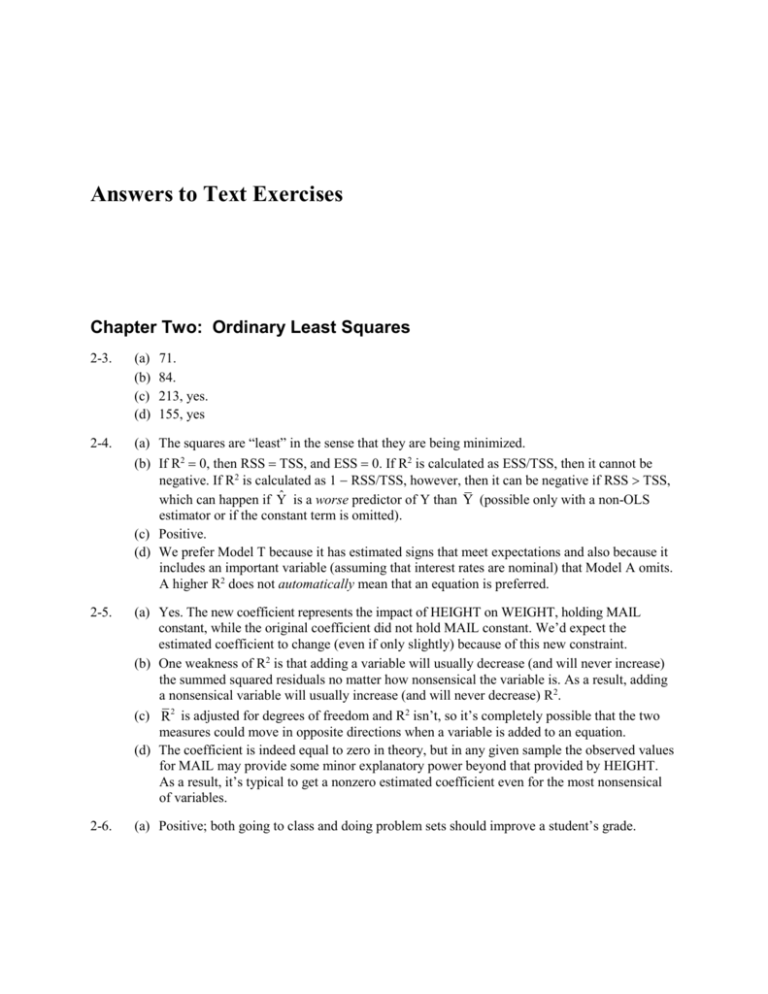
Answers to Text Exercises Chapter Two: Ordinary Least Squares 2-3. (a) (b) (c) (d) 71. 84. 213, yes. 155, yes 2-4. (a) The squares are “least” in the sense that they are being minimized. (b) If R2 0, then RSS TSS, and ESS 0. If R2 is calculated as ESS/TSS, then it cannot be negative. If R2 is calculated as 1 RSS/TSS, however, then it can be negative if RSS TSS, which can happen if Ŷ is a worse predictor of Y than Y (possible only with a non-OLS estimator or if the constant term is omitted). (c) Positive. (d) We prefer Model T because it has estimated signs that meet expectations and also because it includes an important variable (assuming that interest rates are nominal) that Model A omits. A higher R2 does not automatically mean that an equation is preferred. 2-5. (a) Yes. The new coefficient represents the impact of HEIGHT on WEIGHT, holding MAIL constant, while the original coefficient did not hold MAIL constant. We’d expect the estimated coefficient to change (even if only slightly) because of this new constraint. (b) One weakness of R2 is that adding a variable will usually decrease (and will never increase) the summed squared residuals no matter how nonsensical the variable is. As a result, adding a nonsensical variable will usually increase (and will never decrease) R2. (c) R2 is adjusted for degrees of freedom and R2 isn’t, so it’s completely possible that the two measures could move in opposite directions when a variable is added to an equation. (d) The coefficient is indeed equal to zero in theory, but in any given sample the observed values for MAIL may provide some minor explanatory power beyond that provided by HEIGHT. As a result, it’s typical to get a nonzero estimated coefficient even for the most nonsensical of variables. 2-6. (a) Positive; both going to class and doing problem sets should improve a student’s grade. (b) Yes. (c) 0.04 1.74 0.02 0.60, so going to class pays off more. (d) 0.02 1.74 0.10 0.60, so doing problem sets pays off more. Since the units of variables can differ dramatically, coefficient size does not measure importance. (If all variables are measured identically in a properly specified equation, then the size of the coefficient is indeed one measure of importance.) (e) An R2 of 0.33 means that a third of the variation of student grades around their mean can be explained by attendance at lectures and the completion of problem sets. This might seem low to many beginning econometricians, but in fact it’s either about right or perhaps even a bit higher than we might have expected. (f) The most likely variable to add to this equation is the ith student’s GPA or some other measure of student ability. We’d expect both R2 and R2 to rise. 2-7. (a) Even though the fit in Equation A is better, most researchers would prefer Equation B because the signs of the estimated coefficients are as would be expected. In addition, X4 is a theoretically sound variable for a campus track, while X3 seems poorly specified because an especially hot or cold day would discourage fitness runners. (b) The coefficient of an independent variable tells us the impact of a one-unit increase in that variable on the dependent variable holding constant the other explanatory variables in the equation. If we change the other variables in the equation, we’re holding different variables constant, and so the ̂ has a different meaning. 2-8. (a) (b) (c) (d) 2-9. As we’ll learn in Chapters 6 and 7, there’s a lot more to specifying an equation than maximizing R 2 . 2-10. (a) Vi: positive. Hi: negative (although some would argue that in a world of perfect information, drivers would take fewer risks if they knew the state had few hospitals). Ci: ambiguous because a high rate of driving citations could indicate risky driving (raising fatalities) or zealous police citation policies (reducing risky driving and therefore fatalities). (b) No, because the coefficient differences are small and the data will differ from year to year. We’d be more concerned if the coefficients differed by orders of magnitude or changed sign. (c) Since the equation for the second year has similar degrees of freedom and a much lower R2, no calculation is needed to know that the equation for the first year has a higher R2. Just to be sure, we calculated R2 and obtained 0.652 for the first year and 0.565 for the second year. 2-11. (a) It might seem that the higher the percentage body fat, the higher the weight, holding constant height, but muscle weighs more than fat, so it’s possible that a lean, highly muscled man could weigh more than a less well-conditioned man of the same height. (b) We prefer Equation 1.24 because we don’t think F belongs in the equation on theoretical grounds. The meaning of the coefficient of X changes in that F now is held constant. (c) The fact that R2 drops when the percentage body fat is introduced to the equation strengthens our preference for Equation 1.24. (d) This is subtle, but since 0.28 times 12.0 equals 3.36, we have reason to believe that the impact of bodyfat on weight (holding constant height) is very small indeed. That is, moving from average bodyfat to no bodyfat would lower your weight by only 3.36 pounds. Yes. At first glance, perhaps, but see below. Three dissertations, since (978 3) $2934 > (204 2 36 2) $480 ($460 1) $460 The coefficient of D seems to be too high; perhaps it is absorbing the impact of an independent variable that has been omitted from the regression. For example, students may choose a dissertation adviser on the basis of reputation, a variable not in the equation. 2-12. (a) (e2i )/ˆ 2(Yi ˆ0 ˆ1X i )(1) (e2i )/ˆ1 2(Yi ˆ0 ˆ1X i )( ˆ1X i ) (b) 0 2(Yi ˆ0 ˆ1Xi ) 0 2 ˆ1(Yi ˆ0 ˆ1Xi )(Xi ) or, rearranging: Yi nˆ0 ˆ1X i Y X ˆ X ˆ X2 i i 0 i 1 i These are the normal equations. (c) To get ˆ1 , solve the first normal equation for ˆ0 , obtaining ˆ (Y X )/N and substitute this value in for ˆ where it appears in 0 i 1 i 0 the second normal equation, obtaining Yi Xi (Yi ˆ1Xi )(Xi )/N ˆ1X2i , which becomes ˆ (NY X Y X ) /[NX2 (X )2 ]. With some algebraic manipulation 1 i i i i i i (in part using the fact that Xi NX), this simplifies to Equation 2.4. (d) To get Equation 2.5, solve the first normal equation for ˆ0 , using X Xi /N. 2-13. (a) Yes. We’d expect bigger colleges to get more applicants, and we’d expect colleges that used the common application to attract more applicants. It might seem at first that the rank of a college ought to have a positive coefficient, but the variable is defined as 1 best, so we’d expect a negative coefficient for RANK. (b) The meaning of the coefficient of SIZE is that for every increase of one in the size of the student body, we’d expect a college to generate 2.15 more applications, holding RANK and COMMONAP constant. The meaning of the coefficient of RANK is that every one-rank improvement in a college’s U.S. News ranking should generate 32.1 more applications, holding SIZE and COMMONAP constant. These results do not allow us to conclude that a college’s ranking is 15 times more important than the size of that college because the units of the variables SIZE and RANK are quite different in magnitude. On a more philosophical level, it’s risky to draw any general conclusions at all from one regression estimated on a sample of 49 colleges. (c) The meaning of the coefficient of COMMONAP is that a college that switches to using the common application can expect to generate 1222 more applications, holding constant RANK and SIZE. However, this result does not prove that a given college would increase applications by 1222 by switching to the common application. Why not? First, we don’t trust this result because there may well be an omitted relevant variable (or two) and because all but three of the colleges in the sample use the common application. Second, in general, econometric results are evidence that can be used to support an argument, but in and of themselves they don’t come close to “proving” anything. (e) If you drop COMMONAP from the equation, R2 falls from 0.681. This is evidence (but not proof) that COMMONAP belongs in the equation.



